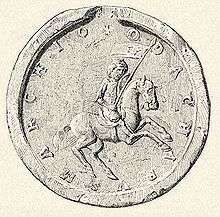Georgenberg Pact
The Georgenberg Pact (German: Georgenberger Handfeste) was signed on 17 August 1186 on the Georgenberg mountain above Enns. Also called the Georgenberg Compact, it has been incorrectly called by English-speaking historians a "Styrian Magna Carta", for it sought to maintain the rights of the Styrian ministeriales in anticipation of the Babenberg acquisition.[1] It consisted of two parts. The first part was an agreement between Duke Ottokar IV of Styria (from the Otakars dynasty) and Duke Leopold V of Austria (from the Babenberg dynasty). The childless and deathly ill Ottokar, who had contracted leprosy while on the Third Crusade, was to give his duchy to Leopold and to his son Frederick under the stipulation that Austria and Styria would henceforth remain undivided. The second part consists of a delineation of rights of the Styrian estates.
The territory of Styria at the time went far beyond the modern Styrian state and included lands not only in modern Slovenia (see Lower Styria), but also in Upper Austria, more precisely the Traungau (the area around Wels and Steyr).
The case of succession came to pass in 1192. With the exception of an interlude between 1194 and 1196, Styria has since then remained connected to Austria. The Georgenberg Pact thus was the first step towards the creation of the complex of lands of Austria, which was continued under the Habsburgs during the Late Middle Ages.
The Pact was confirmed in 1237 by the Holy Roman Emperor Frederick II.[2]


Notes
References
Freed, John B. Noble Bondsmen: Ministerial Marriages in the Archdiocese of Salzburg, 1100-1343. Ithaca, NY: Cornell University Press, 1995)